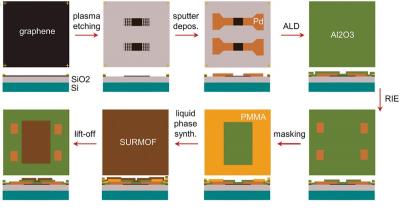Karlsruhe Institute Of Technology (KIT) and Technical University of Darmstadt researchers have developed graphene-enhanced sensors for molecules in the gas phase. The functional principle of this new type of sensors is based on sensitive graphene transistors and tailor-made organometallic coatings. This combination enables selective detection of molecules.
 Fabrication of SURMOF/GFET process flow. Image from article
Fabrication of SURMOF/GFET process flow. Image from article
As a prototype, the authors of the new study demonstrated a specific ethanol sensor that, unlike currently available commercial sensors, does not react to other alcohols or moisture.
Metal-organic frameworks (MOFs) are made up of metallic nodes and organic molecules as connecting struts. Through various combinations, these highly porous crystalline materials can be tailored for various applications, for example - achieving a selective absorption capacity for certain molecules in sensors.
The researchers have demonstrated a selective sensor platform by growing a surface-mounted metal-organic framework (SURMOF) directly on a graphene field effect transistor (GFET). Such a component benefits from the high sensitivity and the simple readout of a GFET as well as from the high selectivity of a SURMOF.
The combination of the unique electronic properties of graphene with the immense chemical variability of MOFs opens up huge potential, says Christof Wöll. Since SURMOFs can be produced in many variants and the interface between GFET and SURMOFs can be designed chemically differently, the work of the researchers from Karlsruhe and Darmstadt could pave the way for a completely new class of sensors with precisely adjusted selectivity and sensitivity. This is where simulation can help, explains Wolfgang Wenzel, since we can build many MOFs on the computer without having to synthesize them.



